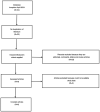Efficacy and safety of transanal opening of intersphincteric space in the treatment of high complex anal fistula: A meta‑analysis
- PMID: 38873039
- PMCID: PMC11170326
- DOI: 10.3892/etm.2024.12595
Efficacy and safety of transanal opening of intersphincteric space in the treatment of high complex anal fistula: A meta‑analysis
Abstract
The best treatment of high complex anal fistula (HCAF) is to avoid anal incontinence while improving the cure rate. On this basis, several surgical procedures for preserving the anal sphincter have been proposed. The purpose of the present study was to evaluate the efficacy and safety of transanal opening of intersphincteric space for treating HCAF. PubMed, Cochrane Library, China National Knowledge Infrastructure and the Wanfang databases were searched to collate all the articles on transanal opening of intersphincteric space for treating HCAF. A total of two researchers independently completed the whole process, from screening and inclusion to data extraction and the data was included in the RevMan 5.3 software for analysis. The main outcomes included the patients' essential characteristics, primary healing rate, management after recurrence, final healing rate, anal incontinence score before and after surgery, postoperative complication rate and types of complications. A total of six articles were included in this meta-analysis. The results showed that the weighted final healing rate of patients following transanal opening of intersphincteric space was 89% [risk differences (RD)=0.89; 95% confidence interval (CI)=0.86-0.92; I2=0%; P<0.00001]. The results of the anal incontinence score showed that there was no significant difference between the results before and after transanal opening of intersphincteric space surgery mean differences [(MD)=-0.04, Cl=-0.10-0.02, I2=0%; P=0.21]. Only 11 patients were reported to have complications, including urinary retention and bleeding following transanal opening of intersphincteric space with a complication rate of 8% (11/138) and the weighted average complication rate was 6% (RD=0.06,95% CI=0.02-0.10; I2=9%; P=0.003). Transanal opening of intersphincteric space has a high cure rate, a favorable anal incontinence score, fewer types of postoperative complications and a low complication rate; it can be used as a minimally invasive and sphincter-preserving surgical method for treating HCAF and is worthy of further promotion and research in clinical practice.
Keywords: complex anal fistula; efficacy; high anal fistula; safety; transanal opening of intersphincteric space.
Copyright: © 2024 Wang et al.
Conflict of interest statement
The authors declare that they have no competing interests.
Figures





Similar articles
-
Comparison between recent sphincter-sparing procedures for complex anal fistulas-ligation of intersphincteric tract vs transanal opening of intersphincteric space.World J Gastrointest Surg. 2022 May 27;14(5):374-382. doi: 10.4240/wjgs.v14.i5.374. World J Gastrointest Surg. 2022. PMID: 35734614 Free PMC article. Review.
-
Transanal opening of the intersphincteric space: a novel sphincter-sparing procedure to treat 325 high complex anal fistulas with long-term follow-up.Colorectal Dis. 2021 May;23(5):1213-1224. doi: 10.1111/codi.15555. Epub 2021 Feb 19. Colorectal Dis. 2021. PMID: 33529491
-
Transanal opening of the intersphincteric space (TROPIS): a novel procedure on the horizon to effectively manage high complex anal fistulas.Ann Coloproctol. 2024 Feb;40(1):74-81. doi: 10.3393/ac.2022.01263.0180. Epub 2023 Oct 24. Ann Coloproctol. 2024. PMID: 38414123 Free PMC article.
-
High complex anal fistula managed by the modified transanal opening of the intersphincteric space via the inter-sphincteric approach: A case report.World J Radiol. 2024 Oct 28;16(10):552-560. doi: 10.4329/wjr.v16.i10.552. World J Radiol. 2024. PMID: 39494138 Free PMC article.
-
Efficacy and Safety of Sphincter-Preserving Surgery in the Treatment of Complex Anal Fistula: A Network Meta-Analysis.Front Surg. 2022 Feb 8;9:825166. doi: 10.3389/fsurg.2022.825166. eCollection 2022. Front Surg. 2022. PMID: 35211503 Free PMC article.
Cited by
-
Recent advances in the diagnosis and treatment of complex anal fistula.Ann Coloproctol. 2024 Aug;40(4):321-335. doi: 10.3393/ac.2024.00325.0046. Epub 2024 Aug 30. Ann Coloproctol. 2024. PMID: 39228196 Free PMC article. Review.
-
Why it is not a good idea to perform a meta-analysis comprising only randomized controlled trials in complex anal fistula?Updates Surg. 2025 Aug 14. doi: 10.1007/s13304-025-02378-9. Online ahead of print. Updates Surg. 2025. PMID: 40813835 No abstract available.
-
Systematic review and meta-analysis of Transanal Opening of Intersphincteric Space (TROPIS) versus conventional treatments for anal fistula.Surg Open Sci. 2025 May 30;27:15-30. doi: 10.1016/j.sopen.2025.05.010. eCollection 2025 Sep. Surg Open Sci. 2025. PMID: 40607121 Free PMC article. Review.
-
Achieving a high cure rate in complex anal fistulas: understanding the conceptual role of the Garg cardinal principles.Ann Coloproctol. 2024 Oct;40(5):521-523. doi: 10.3393/ac.2024.00430.0061. Epub 2024 Oct 25. Ann Coloproctol. 2024. PMID: 39448054 Free PMC article. No abstract available.
-
Structured magnetic resonance imaging and endoanal ultrasound anal fistulas reporting template (SMART): An interdisciplinary Delphi consensus.World J Gastrointest Surg. 2024 Oct 27;16(10):3288-3300. doi: 10.4240/wjgs.v16.i10.3288. World J Gastrointest Surg. 2024. PMID: 39575264 Free PMC article.
References
LinkOut - more resources
Full Text Sources
Miscellaneous
